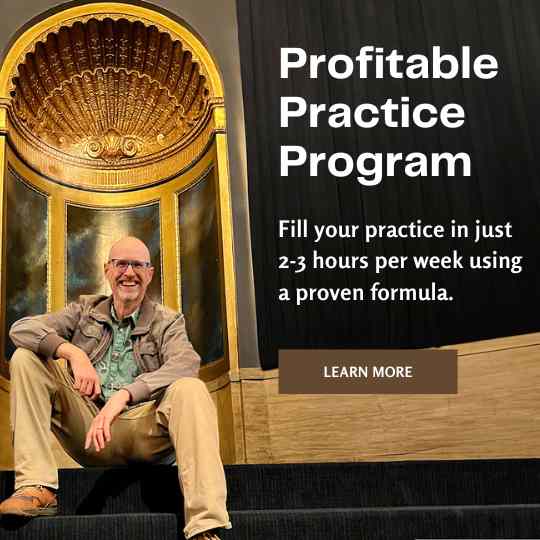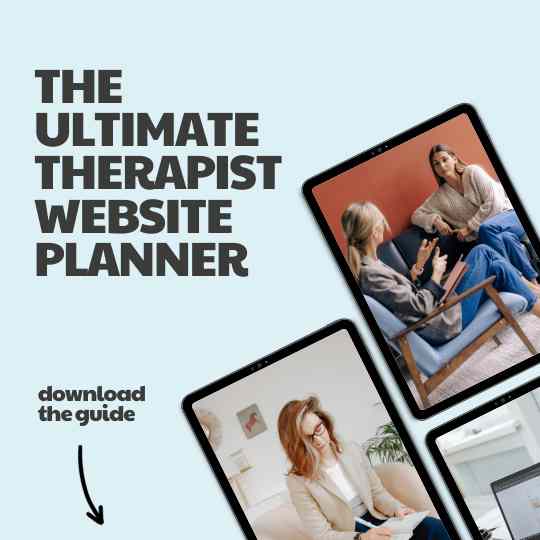Building a profitable therapy practice requires a mix of expertise in mental health and a deep understanding of marketing strategies and client engagement.
Recognizing that every therapy practice has unique needs, this guide serves as a blueprint that can be tailored to suit individual requirements. It’s not a one-size-fits-all solution, but rather a fluid, evolving strategy that changes as your practice grows.
From establishing a strong foundation to connecting with potential clients, converting leads, optimizing strategies, and automating processes, this framework covers every critical aspect of building a successful therapy practice.
The Profitable Practice Framework is the culmination of 18 years of experience as a therapist business coach, web designer, and marketing expert.
It incorporates the very best tools and strategies I have used to grow practices of all sizes: from associates to large mental health clinics. The framework is more than just a marketing strategy; it’s a pathway to empowering therapists in their mission to help others.
Core Components of the Profitable Therapy Practice Framework
- Understand: Build a foundation by identifying your dream client, selecting a niche, setting clear business goals, allocating a marketing budget, and developing a strong brand identity.
- Connect: Create a marketing plan involving content marketing, social media presence, SEO, networking and referrals, paid advertising, community involvement, and listing on therapist directory sites.
- Convert: Enhance your website for user engagement with a user-friendly design, effective copywriting, ethical client testimonials, online scheduling and contact forms, a follow-up system, and CRM integration.
- Optimize: Utilize data and systems efficiently with analytics tools, conversion rate optimization (CRO), conducting market research, and implementing retargeting ads.
- Automate: Streamline marketing and administrative efforts through email marketing automation, social media scheduling, automated reporting, hiring a marketing team, and employing a virtual assistant (VA).
STEP 1
UNDERSTAND:
Build a foundation for sustained success
The journey of creating a profitable therapy practice begins with a deep understanding of its foundational elements. This initial stage is crucial for tailoring your approach to resonate with the specific needs and preferences of your dream clients. It’s about defining who you are as a therapist, what unique value you bring to your clients, and setting clear, achievable business goals.
Each of these components forms the bedrock of your marketing strategy, guiding every decision and action you take to grow your therapy practice. By establishing a solid foundation, you create the roadmap for a successful, thriving practice that not only reaches but effectively serves your target audience.
Identify Your Dream Client
Identifying your dream client is a crucial first step in tailoring your profitable therapy practice to those you can serve best. Think of your dream client as the type of person who not only benefits most from your expertise but also brings you the most professional satisfaction.
Start by considering factors like age, gender, specific challenges or disorders they might be facing, and even personality traits. This understanding helps you create targeted marketing messages and tailor your services to meet their specific needs. You can gather this information through existing client data, surveys, or by envisioning the ideal client you wish to help. This process is not about excluding potential clients but about focusing your efforts to be more effective and personally fulfilling.
Selecting a Niche
Selecting a niche involves focusing your practice on a specific area of therapy or a particular demographic. This could be anything from cognitive-behavioral therapy for anxiety to counseling for couples. Specializing allows you to become more knowledgeable and skilled in a particular area, distinguishing you from general therapists.
It’s important to choose a niche that not only has a demand but is also an area you are passionate about. Research the market, look at what other therapists are doing, and consider your own strengths and interests. Once your niche is identified, it becomes easier to communicate your expertise and attract clients who are looking for your specific services.
Set Business Goals
Setting clear business goals gives you a roadmap to success. These goals should be specific, measurable, achievable, relevant, and time-bound (SMART). Start by setting long-term goals, such as where you want your practice to be in five years, and then break them down into smaller, short-term goals.
Profitable therapy practice goals could include the number of clients you want to see weekly, monthly revenue targets, or goals related to expanding your services. Regularly review and adjust these goals as your practice grows and evolves. Clear goals help you stay focused, make informed decisions, and measure the progress of your practice.
Develop a Marketing Budget
Allocating a marketing budget is essential in ensuring you have the resources to effectively attract your dream clients and run a profitable therapy practice. Many therapists overlook this, especially when starting out, but investing in marketing is investing in the growth of your practice.
Determine what portion of your revenue you can allocate to marketing efforts. This budget should cover website development and maintenance, SEO, content creation, social media management, and any paid advertising. The key is to start small and adjust as you see what works best for your practice. Keep track of your spending and the return on investment (ROI) to understand which strategies yield the best results.
Build a Brand Identity
Building a brand identity is about creating a unique image and voice for your therapy practice. This includes your practice’s name, logo, the colors and fonts you use, and the overall messaging. Your brand should reflect your professional values, your approach to therapy, and what makes your practice different from others.
A strong brand creates a lasting impression and helps potential clients remember and feel connected to your practice. When developing your brand, think about what emotions and messages you want to convey. Consistency across all your marketing materials and online presence is key to building a strong, recognizable brand.
STEP 2
CONNECT:
Make clients aware of your practice
Does it feel like your practice is the best-kept secret out there? With your foundation established, the focus shifts to finding your dream clients online and making them aware of your therapy practice. This stage in the Profitable Practice Framework is all about bridging the gap between your services and the people who need them the most.
Success involves crafting and executing a strategy that encompasses various channels and methodologies, from content marketing that educates and engages, to establishing a strong social media presence that fosters community and connection. Each element of your marketing plan should be tailored to speak directly to your ideal clients, drawing them in and establishing your practice as a trusted source of support and guidance.
Content Marketing
Content marketing is a powerful tool for therapists to establish authority and connect with potential clients. It involves creating and sharing valuable content such as blog posts, videos, podcasts, or infographics that address common issues, questions, or interests of your target audience.
This content should be informative, engaging, and directly relevant to the concerns of your dream client. Effective content marketing not only helps in SEO by incorporating relevant keywords but also provides a resource for clients seeking help, positioning you as an expert in your field. Regularly updating your content keeps your website dynamic and encourages repeat visits, further establishing trust with potential clients.
Social Media
Social media gets a bad rap in the therapy world. While I understand the ethical and confidentiality concerns, I also have seen how Facebook and Instagram can be a beacon of hope — offering validation, transformation, connection, and understanding.
A successful social media feed requires a consistent flow of impactful posts, eye-catching visuals, practical insights, valuable resources, and a touch of self-promotion. The goal is to ethically foster trust, stimulate engagement, and encourage growth.
** FYI — social media marketing is not about immediate results. Instead, think of it as a billboard on the side of the road – a constant presence that gradually builds brand awareness. Then, when your dream client is ready to start therapy, you are the first person on their mind.
Search Engine Optimization (SEO)
SEO is essential for making your website visible to potential clients searching online for therapy services. Optimize your WordPress site with tools like RankMath for keyword integration, site speed improvements, and ensuring your site is mobile-friendly. Consider affordable SEO analysis tools like Serpstat to understand how your website performs against competitors and how you can improve. Consistently updating your website with quality content, maintaining a user-friendly site structure, and ensuring fast load times are key to improving your SEO ranking.
Networking and Referrals
Building a strong network with other professionals can be an invaluable source of referrals. Attend local events, join professional associations, or connect with other therapists and healthcare professionals online. Establishing a referral network requires time and effort but can result in a steady stream of clients who are already pre-screened and more likely to be a good fit for your services. Remember, networking is a two-way street; be ready to refer clients to other professionals when you believe they would be better suited to their services.
Paid Advertising
While organic reach is important, paid advertising can give your practice an extra boost. Platforms like Google Ads and Facebook Ads allow you to target specific demographics, locations, and interests, making your advertising efforts more efficient. Start with a modest budget, test different ad formats and messages, and track the performance to see which ads are most effective. Adjust your strategy based on the data to optimize your ad spend.
Community Involvement
Participating in community events, workshops, or local initiatives can significantly increase your visibility and credibility. Offer to conduct free workshops on mental health, write articles for local newspapers, or participate in health fairs. Community involvement not only helps in building your network but also demonstrates your commitment to the welfare of the community, making potential clients more inclined to trust and choose your services.
Even in 2024, this approach still works. One of my clients got a dozen new clients just by handing out squeezy stress balls with her website URL on them at a health fair in Jersey City.
Therapist Directory Sites
Utilizing therapist directory sites like Psychology Today and GoodTherapy can significantly enhance a therapist’s online presence. These directories are popular among individuals seeking therapy, offering a platform to showcase your practice to a wider audience.
Regularly updating your profile and responding promptly to inquiries can increase your visibility and effectiveness on these platforms. Inclusion in these directories not only boosts your online discoverability but also lends credibility to your practice, as these sites are often seen as reputable sources for finding qualified therapists.
CONVERT:
Turn your dream client into a paying client
Your website is the centerpiece of all your online endeavors. Every element of your marketing – from social media posts to newsletter campaigns – ultimately leads your dream client to your website. This space, free from the distractions and dissonance of the bustling online world, offers a unique opportunity to tell your story and immerse your visitors in an experience that resonates deeply with them.
Once a prospective client reaches out, the real work begins.
This is where a robust intake process and lead tracking system become vital. An efficient intake process ensures that potential clients are quickly and effectively responded to, providing them with the information they need and making them feel valued from their first interaction with your practice. This systematic approach not only optimizes your time but also provides a seamless and professional experience for your clients, increasing the likelihood of them choosing your services.
User-Friendly Design
User-friendly websites for therapists are paramount in converting visitors into clients. This involves a clean, intuitive layout that’s easy to navigate, with a responsive design that adapts to different devices, particularly mobiles. The website should load quickly, have clear calls-to-action (CTAs), and an aesthetically pleasing design that aligns with your brand identity. Utilize simple menus, legible fonts, and ensure that your contact information is easily accessible. Remember, the goal is to make the client’s journey from landing on your site to scheduling an appointment as seamless as possible.
Effective Copywriting
The content on your website should speak directly to your dream client. Use language that resonates with them, focusing on how your services can address their specific concerns and improve their lives. Avoid jargon and make your text welcoming and empathetic, reflecting the supportive nature of your therapy sessions. Highlight your unique selling points and why clients should choose your services. Effective copywriting involves not just what you say, but how you say it, so ensure your website’s tone is consistent with your brand voice.
Here are some of my most popular guides to copywriting for therapists:
- Copywriting for Therapists: a 4-Step Formula for Success
- How to Write Websites that People Want to Read
- How to Magnetically Attract Your Dream Client With Captivating Copy
- ChatGPT For Therapists — How AI Can Write Your Therapist Website
Client Testimonials
Including client testimonials on your website can significantly boost your credibility. Testimonials should reflect diverse experiences and outcomes, showing prospective clients the range of issues you can help with and the benefits of your therapy. However, it’s crucial to navigate the ethical and legal waters carefully. Be mindful of confidentiality and privacy and avoid sharing any information that could potentially identify the client without their written consent.
Online Scheduling and Contact Forms
Incorporating online scheduling and easy-to-use contact forms on your website can greatly enhance the user experience. Tools like Calendly or Acuity Scheduling allow clients to book appointments directly from your site, which can increase conversion rates. Ensure that your contact forms are simple, asking only for essential information to make reaching out as effortless as possible. Prompt responses to these inquiries are crucial in maintaining client interest and trust.
Follow-Up System
Developing an efficient follow-up system is key to converting inquiries into clients. This could involve automated email responses that thank individuals for reaching out and provide them with additional information about your services and what they can expect. Personalized follow-up, perhaps via a phone call or tailored email, can make potential clients feel valued and more likely to schedule an appointment. Using a system like ActiveCampaign can help manage these interactions, ensuring timely and personalized communication.
CRM Integration
Integrating a Customer Relationship Management (CRM) system into your website can streamline the process of managing leads and client information. When choosing a CRM, look for one that combines email marketing capabilities with CRM functionalities, allowing you to keep track of client interactions, automate communication, and manage appointments efficiently. I recommend Active Campaign.
OPTIMIZE:
Use data to get more leads for less money
If you want a profitable therapy practice, the ability to adapt and refine your marketing strategies based on concrete data is crucial. This is not just about driving more traffic to your website; it’s about understanding the behavior of that traffic and making informed decisions to convert visitors into clients more efficiently.
Utilizing analytics tools, engaging in conversion rate optimization, and listening to client feedback are all parts of a continuous cycle of improvement. This process ensures that your marketing efforts are not only reaching your target audience but are also resonating with them in meaningful ways.
Analytics Tools
Using analytics tools, such as Google Analytics, is crucial for understanding how visitors interact with your website. These tools provide valuable data on visitor behavior, traffic sources, page views, and more. This information is essential for making informed decisions about where to focus your marketing efforts.
For example, if you notice that a particular blog post is attracting a lot of traffic, you might decide to create more content on that topic. Similarly, understanding where your traffic is coming from can help you optimize your SEO and advertising strategies. Regular review of these analytics allows you to adapt and refine your marketing approach for maximum efficiency and effectiveness.
Conversion Rate Optimization (CRO)
CRO involves making changes to your website to increase the percentage of visitors who take a desired action, such as filling out a contact form or booking an appointment. Tools like Hotjar or Crazy Egg can provide insights into how users are interacting with your site, showing you what’s working and what isn’t.
This might involve tweaking your website design, changing the placement of your calls-to-action, or modifying the copy on your landing pages. A/B testing different elements on your site can help determine which changes lead to higher conversion rates. Remember, even small changes can have a significant impact on your site’s effectiveness.
Market Research
Staying informed about the latest trends and developments in therapy and marketing is crucial. This could involve reading industry publications, attending workshops and seminars, or participating in online forums and groups. Keeping up with market research helps you understand the changing needs and preferences of your target audience, allowing you to adjust your marketing strategies accordingly. It also ensures that you stay competitive and relevant in an ever-evolving industry.
Retargeting Ads
Retargeting ads are a powerful way to re-engage individuals who have visited your website but didn’t take any action. These ads show up only to people who have already visited your website, reminding them of your services and encouraging them to return to your site.
Retargeting can be a cost-effective way to increase conversions, as you’re reaching out to people who have already shown an interest in your services. Using platforms like Google Ads or Facebook’s advertising tools, you can set up retargeting campaigns that are tailored to specific visitor behaviors, such as visiting a particular page or spending a certain amount of time on your site.
STEP 5
AUTOMATE:
Put your marketing on autopilot
Embracing automation in your profitable therapy practice is essential for shifting your focus from administrative tasks to what truly matters – client care. By setting up automated funnels and lead generation systems, you can efficiently manage your caseload, paving the way for expanding your practice or even starting a group practice.
This approach is crucial for reaching and helping more people without being bogged down by every step of the process.
Administrative tasks, lead generation, follow-up, and marketing, while essential, can be incredibly time-consuming. In the midst of a busy practice, these tasks can sometimes be neglected, especially during times when your intake coordinator is unavailable or your practice is experiencing a high volume of activity.
Automation serves as a strategic solution to these challenges, bypassing potential staffing issues and streamlining operations. Whether it’s through automating email communications, scheduling social media posts, or setting up efficient lead tracking systems, the efficiency gains from automation are not just about saving time; they often translate into a positive return on investment.
Email Marketing Automation
Email marketing automation is a powerful tool for maintaining engagement with potential and existing clients. Platforms like ActiveCampaign allow you to send targeted, timely, and personalized messages to different segments of your audience. You can set up automated sequences for new subscribers, offering them a warm welcome and introducing them to your services.
For existing clients, you can automate appointment reminders, follow-up emails post-session, and regular newsletters with helpful tips or updates about your practice. The key is to provide value in each email, making your clients feel cared for and keeping your practice top-of-mind.
Social Media Scheduling
Consistency in social media posting is crucial for building and maintaining an online presence, but it can be time-consuming. Apps like Later.com can help automate the process by allowing you to schedule posts in advance. This ensures that your social media feeds remain active and engaging, even when you’re busy with clients.
You can plan out weeks’ worth of content in one sitting, ensuring a consistent posting schedule that aligns with your overall marketing strategy. Regular posts keep your audience engaged and can help attract new followers, increasing your online visibility.
Automated Reporting
Automated reporting tools can save a significant amount of time in monitoring your marketing efforts. With Google Analytics, you can set up automated reports that provide insights into website traffic, user behavior, and conversion rates.
These reports can be scheduled to be sent to your email, allowing you to regularly check on the performance of your website and marketing campaigns without having to manually pull data. This can help you quickly identify trends, measure the success of different strategies, and make informed decisions about where to allocate your resources.
Hiring a Marketing Team
For therapists who prefer to focus more on client care than marketing while still having a profitable therapy practice, hiring a marketing team or outsourcing these tasks can be a valuable investment. Professionals can manage your SEO, Google Ads, content creation, and overall marketing strategy.
This not only frees up your time but also ensures that your marketing efforts are handled by experts, potentially leading to better results. It’s important to find a team or individual who understands the unique needs of a therapy practice and can align with your values and approach.
Virtual Assistant (VA)
A virtual assistant (VA) can take over various administrative tasks, streamlining your workflow and allowing you to focus more on your clients. VAs can handle tasks like responding to emails, managing social media responses, following up with leads, and even scheduling appointments.
They act as an extension of your practice, handling the day-to-day tasks that, while important, can be time-consuming for busy therapists. By delegating these tasks, you can ensure that your practice runs smoothly and efficiently, with more time dedicated to providing high-quality care to your clients.
Fill your practice in just 2-3 hours per week
The Profitable Practice Program is specifically designed to help established therapists customize the framework to the unique needs and goals of your practice.
Helping you navigate everything is a seasoned mentor in mental health marketing … plus, an entire Client Generation Team to to take care of all the tech stuff. Here’s what the Profitable Practice Program offers:
- Proven Formula: This program provides a structured approach, filled with strategies that have been successful for hundreds of therapists like you.
- Integrative Approach: Combining personal coaching with collaboration and done-for-you services, the program ensures every aspect of the framework is covered.
- Comprehensive Support: From live coaching to resource-rich learning tools like video trainings, workbooks, and templates, the program equips you to add new private-pay clients, maintain full caseloads, and increase revenue.
- Accountability, Hand Holding, and flexibility: Regular follow-ups and a coaching style that adapts to your needs ensure consistent progress and effective implementation of the framework.
Who is the Profitable Practice Program for?
This comprehensive experience is designed for solo practice owners who are at least 50% full and small group practice owners with 1-5 clinicians who want a new website to get more clients and support their marketing plan.
To succeed, you need to have a strong work ethic, be driven and self-motivated, dedicate 2-3 hours per week, let go of the need for perfection and limiting beliefs about what you “aren’t good at,” and have a $1500+ monthly marketing budget.
If that sounds like you, fill out the form below and schedule a free clarity call to see if the Profitable Practice Program is a fit for your needs and goals.
[gravityform id=”3″ title=”false”]

























